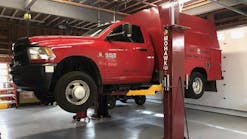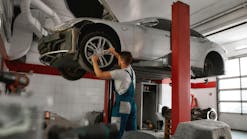Guest Blog: Why semi-truck driver seats should be considered a wear item and replaced regularly
Truck drivers and owners understand how important it is to maintain their rigs to avoid losing time and money due to mechanical issues. Typical maintenance and repair items include tires, fluids, brakes, and so on. However, one wear item that is frequently ignored is the driver’s seat, which directly impacts drivers’ comfort and safety. Many OEM seats lack adequate support when new, and the level of support only diminishes over time as the seat components wear. This wear greatly increases the risk for developing musculoskeletal disorders and soft tissue injuries from being sedentary for long periods of time and is exacerbated by physical effort when strapping down a load, cranking a trailer’s dolly wheels or pulling a fifth-wheel handle. The results are sprains and injuries that can put a driver out of work.
Comparing the cost of losing a worker to an injury to the cost of replacing/upgrading the driver’s seat, it becomes clear that it’s a worthwhile investment. The driver’s seat should be treated with the same consideration given to tires and brakes— inspect on a regular basis, and replace when worn to avoid problems.
Key Considerations When Choosing A Seat Upgrade
Semi-truck seats are considered “suspension seats” since they are mounted on a scissor-type frame that allows for vertical movement to lessen the impact on the body over bumps. An air pressure shock absorber controls the up-and-down movement and stabilizes the seat. OEM seats typically have vinyl upholstery, low seatbacks, and little adjustability, with a cushion width of about 18 inches. All these attributes can be improved with an aftermarket upgraded seat.
When choosing a replacement seat, here are a few key factors to keep in mind:
- Base assembly height: The amount of headroom in your cab will determine whether you can go with a short-base or tall-base and whether you can fit a mid-back or high-back seat. A lower roof will require a shorter base assembly, but if you have the space, a taller seat frame will provide for more vertical travel and more driver comfort.
- Comfort level: Soft and cushy always make a great first impression, but won’t provide needed long-term support. It’s actually the firmer cushions that provide optimal support when remaining in the same seated position for long stretches of time.
- Make sure it has an isolator: An isolator in the base of the seat controls the amount of back-and-forth rocking and minimizes jolts and vibrations when accelerating and braking. Seats with isolators usually have a lever that allows the driver to lock the seat in place when necessary/preferred.
- Extra features/add-ons: In addition to determining which upholstery you like best (cloth, vinyl, leather), there are also seats that offer additional comfort features such as recline and tilt functionality, upper and lower lumbar support, built-in massage, headrest adjustability, and heating/cooling abilities.
Recommendations
With the number of options available for replacement seats, choosing the best one that fits your truck, your budget, and your personal requirements can seem like a lot. Among the brands we carry at TRUCKiD are Bostrom and Minimizer. Be sure to check out all the available optional features, including but not limited to upholstery, cushion width, swivel bases, and memory foam. Any of these features, singularly or in combination, will provide a significant upgrade compared to an OEM seat.
If an entire seat replacement isn’t the best choice for your rig at this time, you can consider related upgrades but on a smaller scale. Seat brackets, seat belts, foam pads, and headrests are all available separately. Whether you go full or partial replacement, there are plenty of choices to improve a driver’s support and comfort during long hours on the road. The goal, of course, is to help drivers stay healthy. Like any other part or system on a truck, it’s important that the condition of the driver seat is monitored and replaced when necessary to ensure the safety and performance of drivers.
Information provided by TRUCKiD


